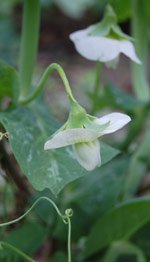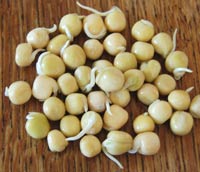Planting Peas for a Popular Home Crop

Planting peas is easy and straightforward. It's getting them to grow successfully that's a bit more difficult!
|
Picture, right: Pea flowers are rather attractive - and you aren't limited to white |
Peas are a worthwhile crop for home growing as long as you are reasonably organised and have enough space to spare. Home grown peas, especially some of the more unusual types, are so delicious that they are worth the fuss. (And you'll save a little money and food miles - all helping towards your green living ideals!)
Here are some basic cultivation notes for planting peas and getting a successful harvest
Select your peas for maximum yield and taste. There are many excellent varieties, especially amongst the heirloom types. Some of them look amazing too. Purple flowers and yellow pods are head-turning additions to the garden. Sugar snap peas are often popular with children and there's less work in that there's no need to shell.
Sponsored links
Planting peas - when to plant
Plant peas when the soil has warmed up in spring - anytime from March onwards. Generally, it's best to wait for the warmer weather in April or May. You can also start peas in the autumn (November) for an early crop the following year.
Planting peas - how much space do they need?
It's important to consider space requirements and to think about how much work you are prepared to put in. Planting peas that grow very tall can yield good crops but they do need adequate support - and this can cost you time and even money to provide. If you are in the country then the easiest way to provide support may be to cut some robust young tree branches (elm sticks are good - hazel too). Some of my neighbours rate using holly twigs to help deter pigeons.
Otherwise you can buy plastic supports which can be less trouble as it's a bit easier to see what's where when it comes to weeding.
Planting peas - soil
Your peas need good rich soil so it's best to use soil which had manure or other fertility added the previous autumn.
Peas are deep rooted and growing peas will benefit your soil. Is it worth growing them in containers? I've never tried but I think it would be challenging to provide both the nutrients and water needed for a successful crop. Maybe next year! See here for more on growing things in a containers
Planting peas - protecting your crop
Peas can also be hard work because the crop needs so much protection. Pigeons enjoy young pea shoots and mice will happily carry off the germinating seeds for breakfast.

Picture: pre-germinating the seed before planting peas can help get your seedlings off to a good start. |
I find it's easiest to pre-germinate them inside and pot them up for a few weeks until the seed pod is no longer needed by the plant. For instructions for pre-germinating peas take a look at this page on sprouting seeds for eating. The method is just the same.
As far as pigeons are concerned, you will almost certainly need to net your peas to protect them. Just one or two pigeons seem to be able to do an immense amount of damage, so if you are determined to grow peas it's worth investing in some good netting.
To deter mice from eating the seed while it is still below ground you could try a paraffin-soaked rag placed in a plant pot nearby. Mice don't like the smell and will avoid the area. A fellow allotment holder I know swears by this method. I haven't tried it yet as the mice seem to prefer her allotment to mine!
Once you have selected your variety and you have pre-germinated some - or not - it's time to plant peas!
Planting peas - plant in rows and net well
Peas are generally planted in double rows. Use a hoe or hand tool to draw a shallow trough in the earth. (Your ground should, of course , be well prepared - free of weeds and stones.) The trough should be about 2 inches deep and 6 inches wide. If the weather is at all dry then pre-water the trough and let the excess water drain away before you begin. You can plant peas anywhere from March to June (northern hemisphere). Avoid cold, very damp or very dry spells.
|
|
Firmly place a pea about every 3 to 4 inches in a zig-zag pattern down the trough. The contact with the soil needs to be good so that the tap root does not sit in an air pocket in the soil. Carefully draw the soil back over the peas and firm it down. You can do this with one foot while balancing on the other. (If you walk over them you will compact the soil too much.)
Net the peas carefully and place bird scarers such as old CDs hung from a line nearby.
If you decide to grow your pea plants in pots or modules first the planting instructions above need some changes. Pot the peas in, two or three to a pot. Water them well and if they are on a windowsill, turn them every few days. Wait till your peas are about 3 or 4 inches high before planting them out. You may need to harden them off by gradually putting them outside and bringing them in again at night.
Make a trench as above and then carefully tip each shoot out of its pot and use a dibber or trowel to make a hole about 3 or 4 inches deep. This is for the root, which will already be quite long. Be careful to drop the root into the hole in such a way that the whole plant does not disappear. Fill in the dirt gently but firmly around each young pea plant.
The next row needs to be at least 2 feet away - more for the larger pea plants. Growing peas need light, space and air. A sunny spot is best. Germination generally takes around a week to 10 days, though they may not show above the soil for longer.
Don't forget to net! You can start your netting off suspended about 6 inches above the ground. You will need to move it upwards as the pea seedling grow.
Planting peas - growing on and support
Once they get to about 8 inches you need to offer some kind of support. Even varieties which are marketed as needing no support will still benefit from some.
If you are using twigs and branches select pieces about 3 - 5 feet high, depending upon your chosen variety (I hope you kept the seed packet!) Preferably choose a damp day when the soil is soft. Strip off any awkward side shoots from the base of the branch to about 10 inches. Push the branch into the soil at least four inches away from any pea plants. This is to avoid disturbing the roots. Arrange the branches so that the twiglets overlap and the pea plants can find side shoots to provide support. Cut enough branches to support all your plants. If these are fresh-cut branches you might want to strip off some of the leaves to maintain light levels (makes it easier to see the peas, too, of course.) You can use old sticks and twigs from last year's prunings but test them out - they must not be too brittle.
If you are using commercial pea supports or pea netting the job is rather more straightforward. Just make sure that the supports themselves are properly supported and secure. Growing peas can become quite heavy as the plants and pods mature.
Planting peas - weeding and companion plants
Once you've done all this, life gets easier. Just try to keep weeds under some control. Once the peas get to about a foot tall they will out-compete many weeds but you still need to be vigilant about the bigger, bossier weeds such as dock or convolvulus.
If you are planting other crops nearby, consider beans, carrots, maize, radish and cucumber. They are all reputed to be suitable "companion" plants for peas. Marigold nearby will also help keep insect pests in check.
You should be able to pick your peas over about a three week period. Pick them regularly to stimulate new growth - you'll find plenty of takers for any excess, no problem! Don't let them get over-mature as they become tough and even slightly bitter and you are more likely to get pests laying eggs in the pods. By staggering planting you can extend the growing season by quite a few weeks, so that you have a reasonably continuous supply for some time.
For more ideas on growing peas successfully, get yourself some good gardening books
such as "Grow Your Own Organic Fruit and Vegetables" by Christine and Michael Lavelle. See my book review page for a review of this book and other gardening books.







New! Comments
Have your say about what you just read! Leave me a comment in the box below.